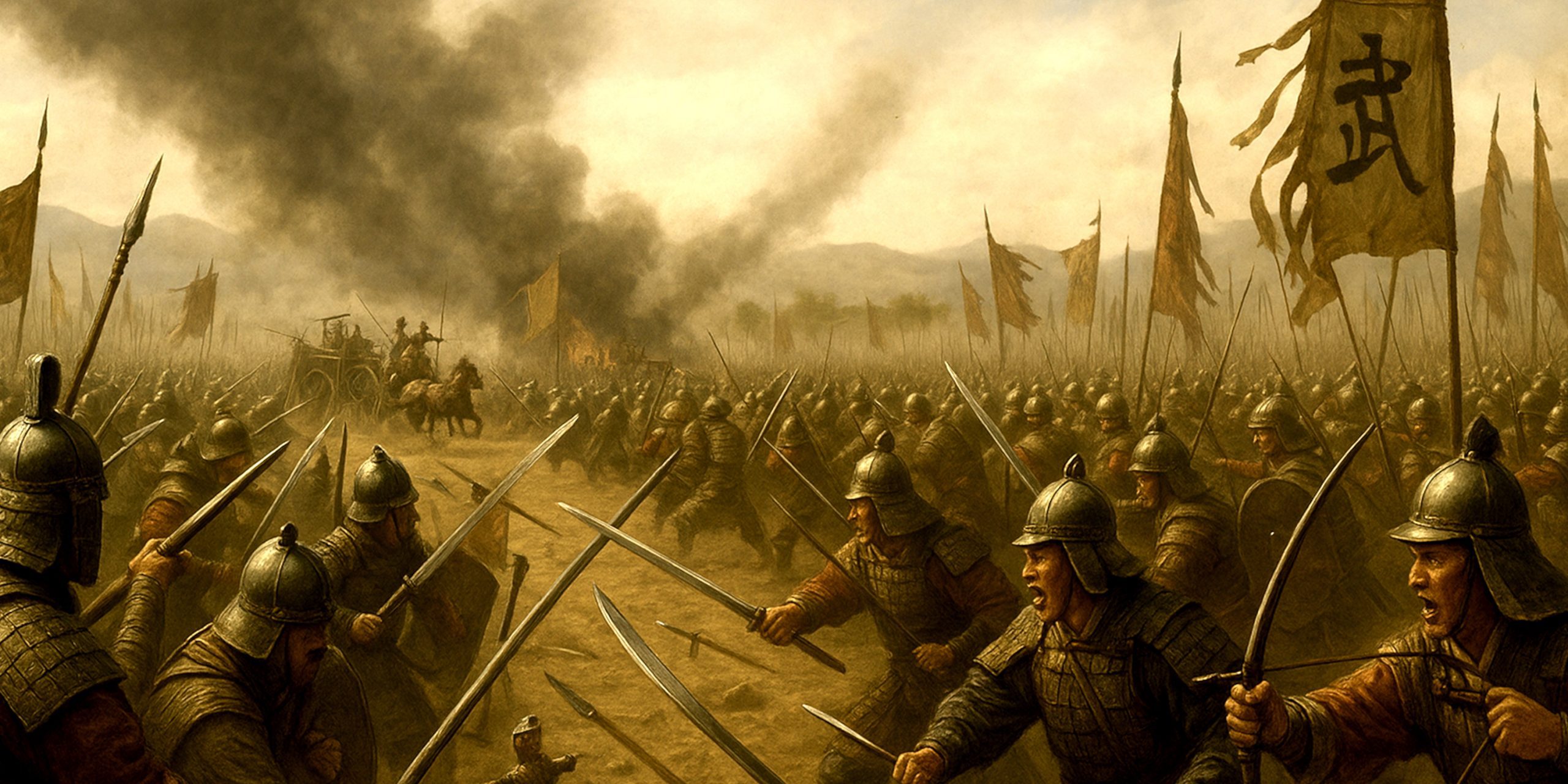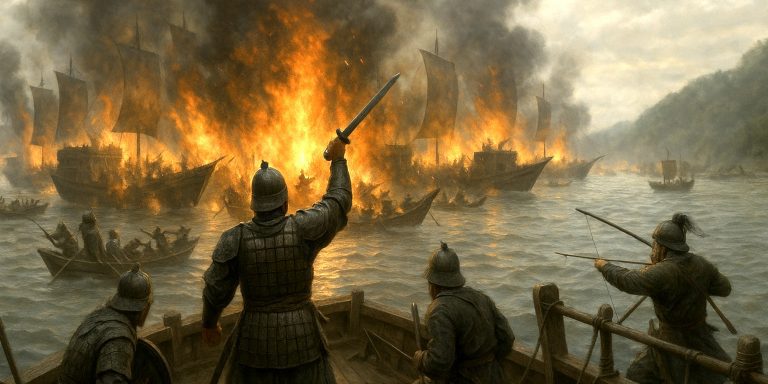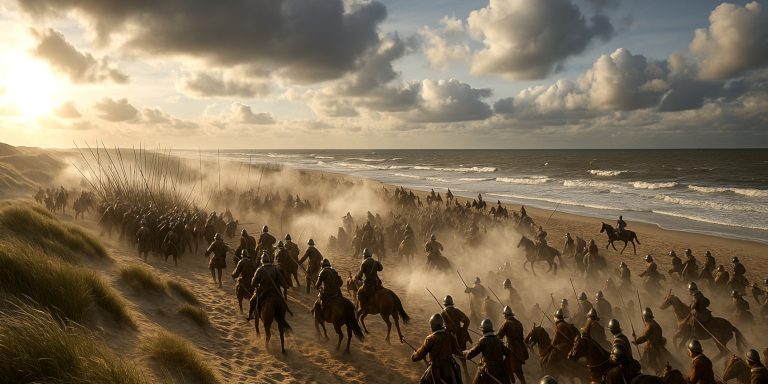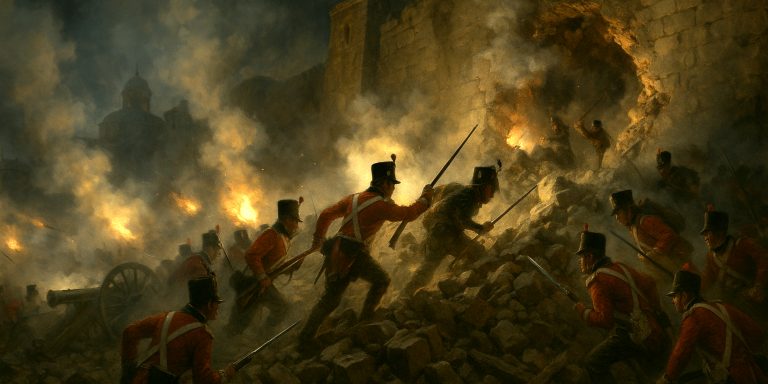
China’s dynasties were forged and broken by battle. From the bronze-age chariots of the Shang to the gunpowder weapons of the Qing, warfare shaped dynastic change and cultural evolution. Below is a chronological account of the most decisive battles in Chinese history, with a focus on commanders, troop numbers, outcomes, and the exact weapons and armour employed.
Shang Dynasty (c. 1600–1046 BC)
The Shang were China’s first historically confirmed dynasty. They relied on bronze technology, divination rituals, and war chariots to maintain power. Their armies were led by a warrior aristocracy, supported by bronze weaponry and ritualised combat.
Battle of Muye (c. 1046 BC)
Summary: King Wu of Zhou rebelled against the Shang. Despite a larger army, Shang morale collapsed and many soldiers defected.
Commanders:
- Zhou: King Wu
- Shang: King Zhou of Shang
Troop Estimates:
- Zhou: c. 50,000
- Shang: c. 70,000
Weapons and Armour Used:
- Ge (dagger-axe): bronze blade mounted on a pole, the dominant weapon of Shang warfare.
- Bronze jian (straight, double-edged swords).
- Composite bows of horn and sinew.
- Chariots with bronze fittings, often carrying archers.
- Armour: leather or bronze scale cuirasses, bronze helmets.
Outcome: The Shang army disintegrated, and King Zhou of Shang killed himself.
Legacy: The Zhou victory introduced the Mandate of Heaven doctrine, shaping Chinese political legitimacy for centuries.
Zhou Dynasty (1046–256 BC)
The Zhou saw China expand and fragment into feudal states. By the Warring States period, warfare became larger, more professional, and brutal. Iron weapons, cavalry, and mass infantry with crossbows transformed the battlefield.
Battle of Changping (260 BC)
Summary: Qin forces under Bai Qi annihilated the Zhao army in one of the deadliest battles of the Warring States period.
Commanders:
- Qin: Bai Qi
- Zhao: Zhao Kuo
Troop Estimates:
- Qin: c. 600,000
- Zhao: c. 450,000
Weapons and Armour Used:
- Iron jian and dao (straight double-edged and single-edged sabres).
- Qiang (long spears).
- Crossbows with bronze trigger mechanisms.
- Ji (halberds combining spear and axe).
- Armour: lamellar cuirasses of leather and bronze plates.
Outcome: Zhao’s army was encircled and executed en masse.
Legacy: Qin dominance grew, paving the way for the unification of China in 221 BC.
Han Dynasty (206 BC–220 AD)
The Han built a centralised empire and expanded across Asia. They fielded huge infantry armies supported by cavalry, repeating crossbows, and iron weapons. The jian sword reached its peak, symbolising both scholarly refinement and military strength.
Battle of Red Cliffs (208 AD)
Summary: Cao Cao’s vast fleet was destroyed by Sun Quan and Liu Bei’s alliance, preventing his unification of China.
Commanders:
- Cao Cao
- Sun Quan, Liu Bei, Zhou Yu
Troop Estimates:
- Cao Cao: c. 220,000
- Allies: c. 50,000
Weapons and Armour Used:
- Han jian (refined double-edged iron swords).
- Dao for infantry close combat.
- Repeating crossbows (nu).
- Halberds (ji) and qiang spears.
- War junks armed with catapults and fire ships.
- Armour: iron lamellar for infantry and cavalry, leather for sailors.
Outcome: Fire ships destroyed Cao Cao’s chained fleet.
Legacy: The battle fragmented China into the Three Kingdoms, later immortalised in literature and folklore.
Tang Dynasty (618–907)
The Tang expanded China’s borders through cavalry campaigns and international trade. Their armies were professional, with heavy cavalry, crossbows, and steel swords. Tang armour combined iron lamellae and leather for flexibility.
Battle of Talas (751)
Summary: Tang expansion westwards was halted after defeat by the Abbasid Caliphate and betrayal by Karluk allies.
Commanders:
- Tang: Gao Xianzhi
- Abbasid: Ziyad ibn Salih
Troop Estimates:
- Tang: 30,000–40,000
- Abbasid: 20,000–30,000
Weapons and Armour Used:
- Tang dao (curved sabres).
- Tang jian for officers and elite soldiers.
- Crossbows with steel components.
- Lances for heavy cavalry.
- Abbasid forces used spears, curved swords, and mounted archery.
- Armour: Tang lamellar cuirasses, helmets with plume crests.
Outcome: Tang forces were defeated and expelled from Central Asia.
Legacy: Chinese westward expansion ended. Papermaking knowledge passed into the Islamic world, influencing global civilisation.
Song Dynasty (960–1279)
The Song excelled in culture and technology but struggled militarily. They pioneered gunpowder in warfare, creating fire lances, grenades, and early cannon. Song naval power was advanced, with paddle-wheel ships and flamethrowers, but their land armies were vulnerable to nomadic cavalry.
Battle of Yamen (1279)
Summary: The Song made their final naval stand against the Mongols. Their fleet was encircled and destroyed, and the young emperor drowned.
Commanders:
- Song: Zhang Shijie, Lu Xiufu
- Yuan: Zhang Hongfan
Troop Estimates:
- Song: c. 200,000
- Yuan: 20,000–30,000
Weapons and Armour Used:
- Fire lances (early gunpowder flamethrowers).
- Gunpowder bombs (huo pao).
- Crossbows and steel jian swords.
- Paddle-wheel warships with mounted trebuchets.
- Armour: iron and steel lamellar, supplemented by leather for sailors.
Outcome: The Song fleet was destroyed.
Legacy: The fall of Yamen ended the Song dynasty and secured Mongol rule in China.
Yuan Dynasty (1271–1368)
The Yuan, founded by Kublai Khan, integrated Mongol steppe traditions with Chinese administration. Mongol warfare relied on cavalry archers but also adopted Chinese naval and siege technologies. Their rule faced constant rebellions, leading to their downfall.
Battle of Lake Poyang (1363)
Summary: Rival rebel leaders fought for control of the collapsing Yuan empire. Zhu Yuanzhang’s smaller fleet defeated Chen Youliang’s much larger force.
Commanders:
- Zhu Yuanzhang
- Chen Youliang
Troop Estimates:
- Zhu: 200,000 on 2,000 ships
- Chen: 650,000 on 600 ships
Weapons and Armour Used:
- Dao sabres for close combat.
- Naval trebuchets hurling incendiary projectiles.
- Crossbows and spears.
- Fire ships loaded with combustibles.
- Armour: mixed iron lamellar and Mongol leather scale.
Outcome: Zhu Yuanzhang triumphed, sinking Chen’s fleet.
Legacy: Zhu founded the Ming dynasty, ushering in a period of prosperity and stability.
Ming Dynasty (1368–1644)
The Ming restored Han rule and oversaw vast projects like the Great Wall and Forbidden City. Its armies combined gunpowder artillery with traditional weapons. Cavalry carried dao sabres and qiang spears, while infantry wielded crossbows, matchlocks, and polearms.
Battle of Shanhai Pass (1644)
Summary: Ming general Wu Sangui allied with the Manchu against rebel forces. The Manchu entered through Shanhai Pass, defeating Li Zicheng’s rebels and taking Beijing.
Commanders:
- Wu Sangui, Dorgon (Manchu)
- Li Zicheng (rebels)
Troop Estimates:
- Ming/Manchu: 80,000
- Rebels: 200,000
Weapons and Armour Used:
- Dao sabres for cavalry.
- Matchlock muskets and cannons.
- Spears and halberds for infantry.
- Armour: brigandine coats with metal plates, iron helmets.
Outcome: Rebel forces were crushed, and Beijing fell to the Manchu.
Legacy: This battle marked the fall of the Ming and the rise of the Qing dynasty.
Qing Dynasty (1644–1912)
The Qing expanded China’s borders and absorbed new technologies. Their armies used banner cavalry with sabres, muskets, and lances, supported by artillery. Over time, they increasingly relied on European firearms. Rebellions and Western imperialism eroded their strength.
Battle of Nanjing (1864) – Taiping Rebellion
Summary: Qing forces besieged and captured Nanjing, ending the Taiping Heavenly Kingdom.
Commanders:
- Qing: Zeng Guofan, Li Hongzhang
- Taiping: Hong Xiuquan, Li Xiucheng
Troop Estimates:
- Qing: 500,000
- Taiping: 200,000
Weapons and Armour Used:
- Dao sabres and spears for traditional close combat.
- Muskets (matchlock, flintlock, and imported rifles).
- Cannons and howitzers, some European-made.
- Siege towers and explosives.
- Armour: limited, with soldiers often unarmoured due to firearms dominance.
Outcome: Nanjing fell with catastrophic loss of life.
Legacy: The rebellion cost 20–30 million lives, weakened the Qing, and accelerated reliance on foreign support, hastening imperial decline.
The Seven Swords Takeaway
From the dagger-axes of Muye to the rifles at Nanjing, these battles demonstrate the evolution of Chinese arms and armour alongside dynastic change. Each conflict marked a turning point, not only ending regimes but shaping the identity and resilience of Chinese civilisation across four millennia.



